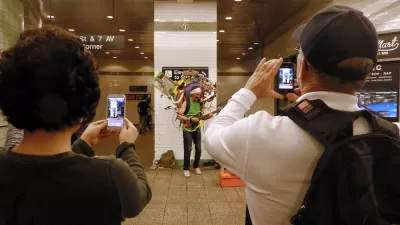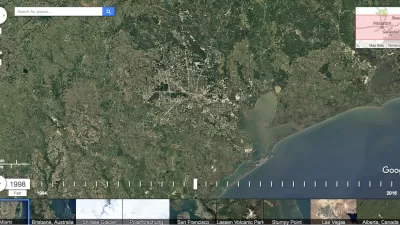Someone's done the hard work of finding, sorting, and stitching together millions of photos from the Internet to create animated portraits of the evolution of places.
James Vincent reports on a new project from researchers at Google and the University of Washington that animates places around the world by crowd sourcing publicly available images. Vincent explains:
"Researchers from Google and the University of Washington have found a way though, creating a powerful set of algorithms that automatically sorts millions of online photos into time-lapses of everything from skyscrapers to glaciers. The internet is plugged in at one end, and a record of our changing world comes out the other." They call it 'time-lapse mining.'"
The work allowed the team to create thousands of time-lapses of the most popular places on Earth—everything ranging from the Las Vegas Strip to the Briksdalsbreen Glacier in Norway, which you can see in the video below.
A paper documenting the work and more info is available at the project website.
FULL STORY: Public photos mined to create beautiful time-lapses

Alabama: Trump Terminates Settlements for Black Communities Harmed By Raw Sewage
Trump deemed the landmark civil rights agreement “illegal DEI and environmental justice policy.”

Study: Maui’s Plan to Convert Vacation Rentals to Long-Term Housing Could Cause Nearly $1 Billion Economic Loss
The plan would reduce visitor accommodation by 25% resulting in 1,900 jobs lost.

Why Should We Subsidize Public Transportation?
Many public transit agencies face financial stress due to rising costs, declining fare revenue, and declining subsidies. Transit advocates must provide a strong business case for increasing public transit funding.

Paris Bike Boom Leads to Steep Drop in Air Pollution
The French city’s air quality has improved dramatically in the past 20 years, coinciding with a growth in cycling.

Why Housing Costs More to Build in California Than in Texas
Hard costs like labor and materials combined with ‘soft’ costs such as permitting make building in the San Francisco Bay Area almost three times as costly as in Texas cities.

San Diego County Sees a Rise in Urban Coyotes
San Diego County experiences a rise in urban coyotes, as sightings become prevalent throughout its urban neighbourhoods and surrounding areas.
Urban Design for Planners 1: Software Tools
This six-course series explores essential urban design concepts using open source software and equips planners with the tools they need to participate fully in the urban design process.
Planning for Universal Design
Learn the tools for implementing Universal Design in planning regulations.
Smith Gee Studio
Alamo Area Metropolitan Planning Organization
City of Santa Clarita
Institute for Housing and Urban Development Studies (IHS)
City of Grandview
Harvard GSD Executive Education
Toledo-Lucas County Plan Commissions
Salt Lake City
NYU Wagner Graduate School of Public Service





























